Meet the Founder - a Brief Introduction & Overview
I have been a Certified Service Dog Access Specialist through the Delta Societies National Service Dog Center since 1996.
My Service Dogs and I have been members of: The International Association of Assistance Dog Partners (iaadp.org)
I was the catalyst for IAADP recognizing Service Dogs for PTSD and the Mentally Ill as full Assistance Dogs. I was one of the first to talk publicly and to the media about my personal use of a task-trained Service Dog for PTSD and other Mental illnesses in 1996.
IAADP is a Consumer Organization made up of people with disabilities that use Assistance Dogs. The disabilities are a cross-section of all disabilities Assistance Dogs have/can be trained to assist with. I was on the Board of Directors for 6 years.
IAADP worked with the Department of Justice, the Department of Transportation, and Homeland Security/FEMA to make the needs of the community of people with disabilities and that use Assistance Dogs easier, and in the case of Homeland Security/FEMA, to save lives in Emergencies. I was able to take part in the National Center for Emergency Preparedness in re-writing the policies and procedures for how the disabled will be served during disasters in the future. This was my proudest moment. The work I have done with the DOJ and DOT has/will make life easier for the disabled. What I did with the National Center for Emergency Preparedness, and will be doing with the Department of Homeland Security/FEMA, Nation Response Plan/National Incident Management System will save the LIVES of the disabled.
I was Pet Partner at Tri-City Medical Center and Chairman for Tender Loving Canines (the animal-assisted therapy program at Tri-City) for 14 years. I have been a licensed Animal Handler Instructor, and Animal Team Evaluator, through the Delta Society for 14 years.
In June of 2002, I became a member of HOPE Crisis AAES; these are dogs trained to work in disasters, local or national, to help with stress relief and debriefing for crisis responders and friends and family members of victims. Many of these dog/handler teams were in New York City the first week, as well as several times during the 9 months of "clean up."
I have had 40 hours of training as a Crisis Response Team member for NOVA (National Organization for Victims Assistance) through the Governor's Office of Criminal Justice Preparedness for the State of California.
I have had articles published in the newsletter of several professional organizations. I have been a workshop presenter at several National Conferences
NOVA 1999 & 2000
Consumer Mental Health Conference in Portland, OR, 2000
Third National Conference on Women (SAMHSA) June 2001
IVAT (Institute on Violence Abuse and Trauma) Sept. 2005-2009
My workshop was selected by the University of California at San Diego and the American Medical Association for Continuing Medical Educational Credits.
I have worked with many organizations to educate on Service Dog Access Rights, some of which include:
I was a member of NOVA (National Organization for Victims Assistance) and an independent contractor for the Office of Victims of Crimes (OVC) Technical Training and Assistance Center (TTAC), both are branches of the Department of Justice.
I worked with Paul Greenwood, Deputy District Attorney of San Diego County, CA, with TRIAD/SALT on Elder Abuse issues. I was also a member of the Victims Assistance Coordination Council here in San Diego.
My Educational background as a Certified Drug and Alcohol Counselor; (I worked for The Marine Corps at the Consolidated Drug and Alcohol Counseling Center at Camp Pendleton, CA, where I did individual case management and "aftercare"). I was also trained as a Certified Crisis Intervention Counselor, at Family Services, at Camp Pendleton.
I would never have thought that my training in Alcohol Family Dynamics would have anything to offer in working with people with disabilities and Assistance Dogs. Actually, studies have proven that the same Family Dynamics apply to many types of Family Dynamics; having a disabled family member is one. Most people who call me for help are in "crisis," so here, once again, my past educational training has paid off in my new field. Helping people calm down and find places to get help, Advocacy is a must before they can even hear what is being said about the issues they are dealing with.
For 3 years, I was an instructor at Palomar College for the Japanese exchange students here in the USA to study Alternative Treatments for Children and Elders with Disabilities. In, 2006, a Delegation representing the Government of Japan came to my home for some educational information on how the USA went from only allowing Guide Dogs public access rights to giving ALL Assistance Dogs public access rights. Three years after their visit, it became law in Japan.
Three articles I have written have been published in Physical and Occupational Therapy professional publication on how Assistance Dogs and Animal-assisted Therapy Animals can benefit their patients.
My goal is to continue to do what I LOVE educating about what dogs can be trained to do to assist many diverse disabilities for individuals and educate businesses on the ADA.
I want very much to expand my educational training regarding Assistance and Animal Assisted Therapy to Medical Doctors and Psychological Professionals. This is a segment of the population that has been the most difficult to reach.
My Personal Assistance Dogs
Bubba Blue 1st Assistance Dog
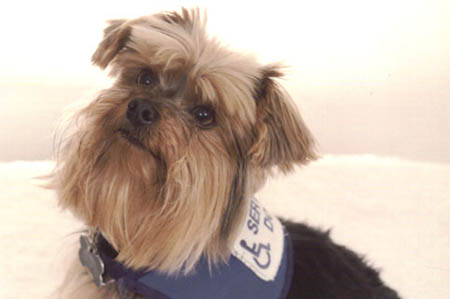
Bubba Herding Sheep
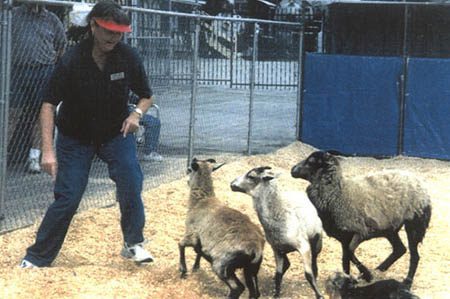
Bubba Blue 1st Assistance Dog

Bubba Blue was a rescue that came into my life in 1995. I was his 5th home; he was 3 years old. I got him as a pet. He was a 7-pound Yorkie. Little did I know that Bubba would instinctively alert me to my Medical Conditions.
Once I became aware of this, I worked with a Professional Dog Trainer, who trained me to train Bubba. (She always said I was harder to train than the dog.) We reinforced the alerting behaviors so that they became predictable and consistent, thus a trained "task." Bubba took care of me for 11 years. He crossed over in Jan. of 2007.
In the second picture, if you look in the lower right corner, you will see a 7-pound Yorkie herding sheep. I've heard many people concerned that Assistance Dogs don't get to have any fun. This was what Bubba loved to do in his "off duty time."
Dr. Marty Becker (DMV), who at that time was the Veterinarian Consultant for Good Morning America, wrote a book called The Healing Power of Pets --- ours (Bubba and my) is the first story in the chapter on Assistant Dogs. Along with this story, I have had several articles published in various publications nationally.
King's spirit of Braveheart (Heart) was my second Service Dog. Bubba helped me train my Heart. Heart was a 5.5-pound Yorkie. My Heart picked up, alerting me to my Medical Conditions and low blood sugar. I had just been diagnosed with Type II Diabetes.
Heart was attacked in my backyard by a coyote that really did some physical, and I later learned neurological damage to him at 15 months old. I loved this dog, and at the time, once his physical wounds had healed, I thought he had doggie PTSD. Well, as his handler, I had PTSD, so I was just sure he would still be a great Service Dog, and we would make a great team. There is a term called "kennel blindness," meaning a person is so emotionally invested in a dog or breed that they fail to see the flaws or faults with the specific dog or breed. That is what I did with Heart. Bless his heart; he gave me his all. However, it was unfair and unacceptable of me to ask him to be a Service Dog.
I retired Heart at about 5 years old. Heart had horrible allergies all of his life. At the end of his life, I was spending $9,000 a year to keep him comfortable with his skin condition. He started having seizures that lasted 25 minutes long. We put him on medication, and it helped some. Then in one week, Heart had two strokes. He could not walk straight or hold his head up…..I just could not leave this wonderful little dog in this shape. I took him as an Emergency to my Vet Clinic. Heart crossed over to Rainbow Bridge at 6 years old, on Sept. 15, 2009. My personal Vet called me about a week later and told me that after studying my Heart's Medical Records again, the Vet really believed that my Heart had a brain tumor.
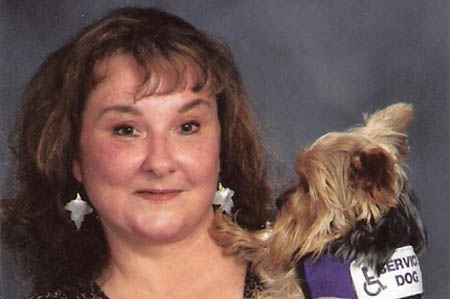
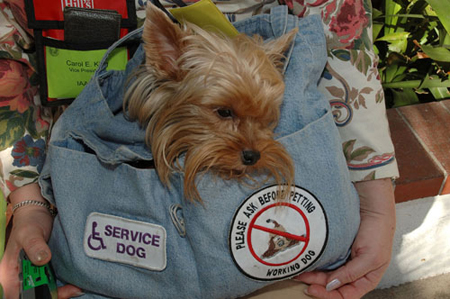
Heart in his bag with me
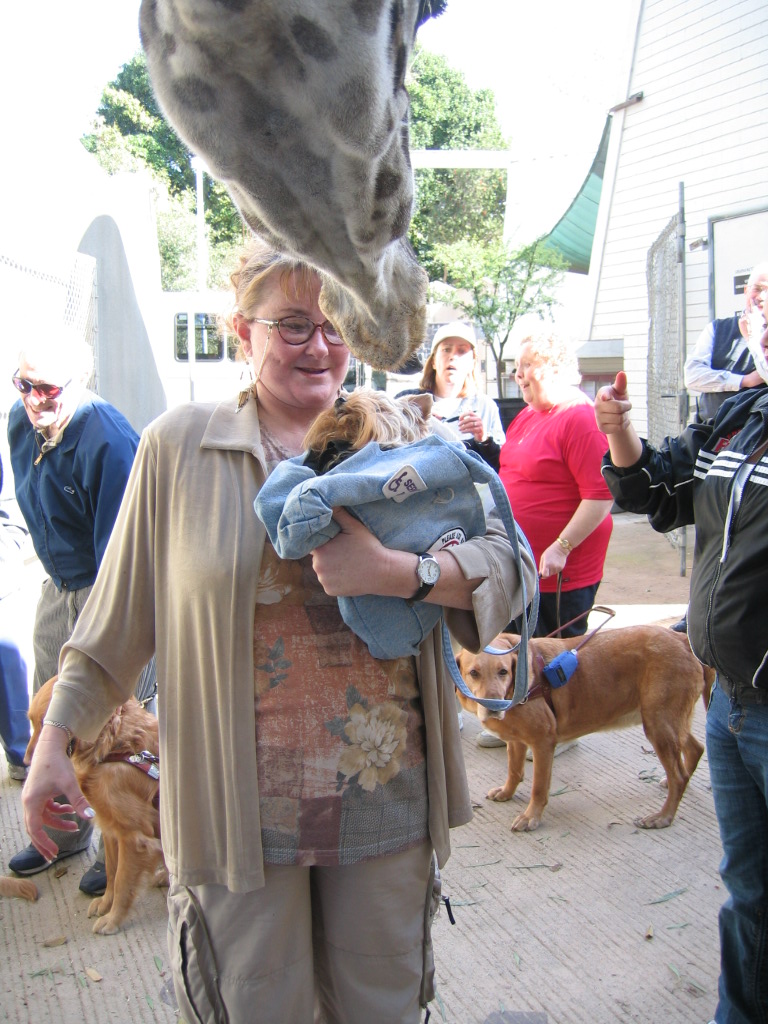


Carol and Cammie
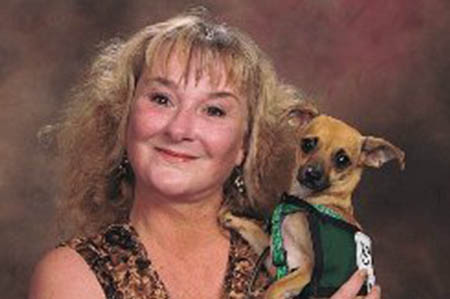
Carol and Sky

Cammie

Sky
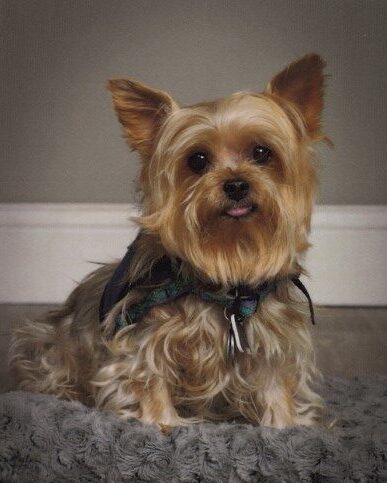
9 year old Yorkshire Terrier
Cammie is a Chi-Jack Russell mix of 6.5 pounds. I was without a Service Dog for 9 months after I retired Heart. I looked everywhere. I wanted another Yorkie; however, I could not find one that fit my needs. Cammie was picked up as a stray by my local animal shelter. He was very interested in sounds, friendly, and persistent. Lots of energy and drive traits are needed in a Hearing Dog. By now, I was wearing Hearing Aids and had lost half my hearing. He was 1 year old.
The first week I brought him home, he chewed off his harness and the harnesses off the other two dogs at home. Took my cell phone and TV remote and anything else he could get a hold of through the pet door and outside. This was/is one smart dog. He needed a job to keep his sharp little mind busy and out of trouble. We started obedience classes right away. Then I took him out to places dogs were allowed to follow up the obedience with public access training.
I then took him through another 6 weeks of obedience classes. Service Dogs need to have a professional-grade of obedience, not a pet grade. He finished the classes with flying colors, even if I did have to dress him for a blizzard. Cammie freezes and shivers if it is 92 degrees outside and he is in the shade. The classes were in the evening the temp. Dropped to 65 degrees. Poor little dog.
I then began putting a hearing task on Cammie. Now I can train a dog for obedience and further for very professional public access obedience. Task training is a challenge for me. I've taken all the training classes, understand all the concepts, etc. I lack personal consistence and personal motivational drive to follow through with the task.
My best friend, that had helped me train my other two dogs, had died. So I was on my own. I did get Cammie trained to alert me to the phone ringing, and if I was sleeping on my good ear and did not hear it, the alarm clock, he would wake me up.
I have glaucoma and must take eye drops every night before bed. I seem to be able to remember to take my pills, but I fail horribly with the eye drops. I did train Cammie to remind me at bedtime to take my eye drops. I keep the eye drop bottle in a larger bottle of dog treats. So when Cammie reminds me to take the drops, Cammie gets a doggie treat.
As a bonus of having a Service Dog, Cammie helps me with some of my other medical conditions; however, he is not task trained for those.
At present, I invested most of my time with IVAT (Institute on Violence Abuse and Trauma) ivat.org and NPEIV (National Partnership to End Interpersonal Violence) npeiv.org. My specific project is educating on the direct connection between human (any age, social, economic, ethnic group) abuse and animal abuse.